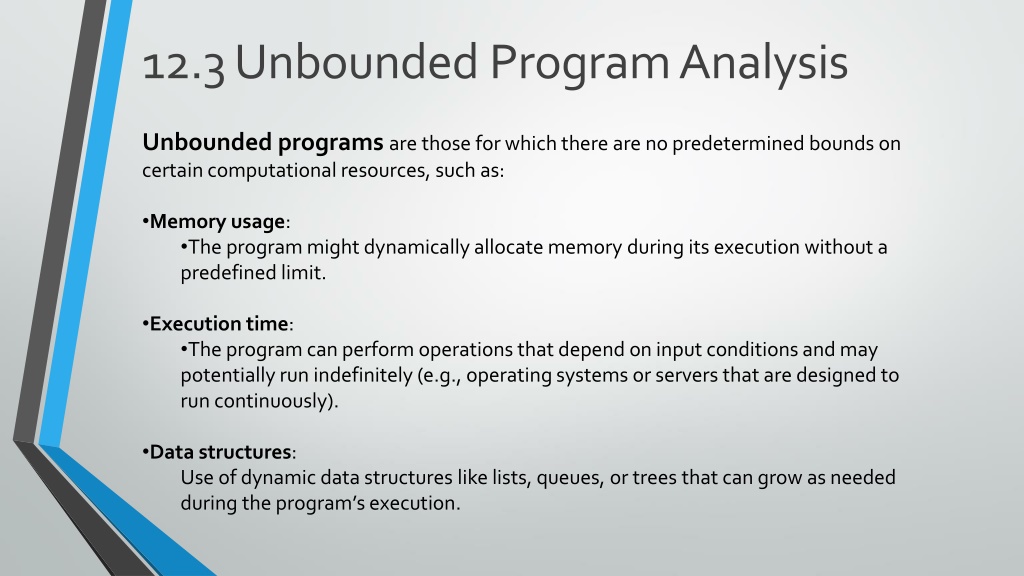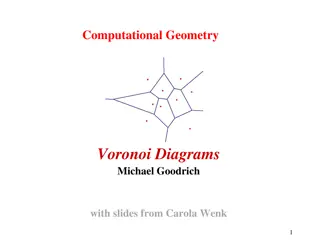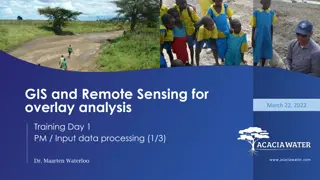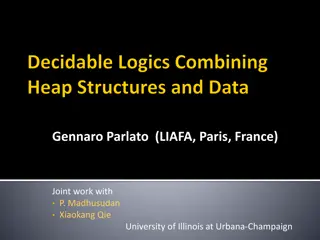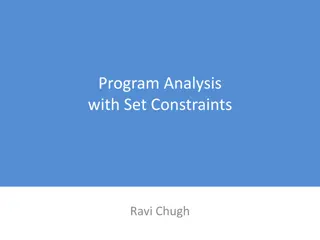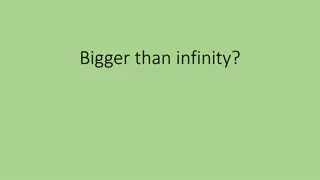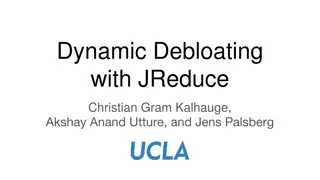Challenges of Unbounded Program Analysis
Verifying unbounded programs poses challenges due to the undecidability of certain computational resources like memory usage, execution time, and data structures. The presence of infinite execution paths, unbounded loops, recursion, and dynamic memory allocation makes it difficult to determine program behavior conclusively. Techniques such as overapproximation with nondeterministic assignments are utilized to manage the complexity of analyzing unbounded programs.
Download Presentation

Please find below an Image/Link to download the presentation.
The content on the website is provided AS IS for your information and personal use only. It may not be sold, licensed, or shared on other websites without obtaining consent from the author.If you encounter any issues during the download, it is possible that the publisher has removed the file from their server.
You are allowed to download the files provided on this website for personal or commercial use, subject to the condition that they are used lawfully. All files are the property of their respective owners.
The content on the website is provided AS IS for your information and personal use only. It may not be sold, licensed, or shared on other websites without obtaining consent from the author.
E N D
Presentation Transcript
12.3 Unbounded Program Analysis Unbounded programsare those for which there are no predetermined bounds on certain computational resources, such as: Memory usage: The program might dynamically allocate memory during its execution without a predefined limit. Execution time: The program can perform operations that depend on input conditions and may potentially run indefinitely (e.g., operating systems or servers that are designed to run continuously). Data structures: Use of dynamic data structures like lists, queues, or trees that can grow as needed during the program s execution.
12.3 Unbounded Program Analysis Challenges: Verifying unbounded programs is generally undecidable No universal decision procedure exists for all programs What makes the problem undecidable? - Infinite Execution Paths: The presence of unbounded loops, recursion, and dynamic memory allocation can lead to an infinite number of potential execution paths.
12.3 Unbounded Program Analysis Undecidability Undecidability (Unrecognizable): The verification of unbounded programs is undecidable because it is infeasible to exhaustively analyze all potential states. This is related to the Halting problem , and we know that its semi- decidable problem
12.3.1Overapproximation with Nondeterministic Assignments Under-Approximation (Technique from Sect. 12.2.2 ) Translates program into a formula with bounded loop depth Underapproximates program behavior Cannot confirm assertions beyond the bound Over-Approximation a new program transformation Converts a program with loops into a loop-free program Overapproximates the original program behavior Allows claims about executions of arbitrary length
12.3.1 Overapproxaimation with Nondeterministic Assignments For each loop and each program variable that is modified by the loop, add an assignment at the beginning of the loop that assigns a nondeterministic value to the variable. After each loop, add an assumption that the negation of the loop condition holds. An assumption is a program statement assume(c) that aborts any path that does not satisfy c. Replace each while loop with an if statement using the condition of the loop as the condition of the if statement.
12.3.1 Overapproxaimation with Nondeterministic Assignments For each loop and each program variable that is modified by the loop, add an assignment at the beginning of the loop that assigns a nondeterministic value to the variable. After each loop, add an assumption that the negation of the loop condition holds. An assumption is a program statement assume(c) that aborts any path that does not satisfy c. Replace each while loop with an if statement using the condition of the loop as the condition of the if statement.
12.3.1 Overapproxaimation with Nondeterministic Assignments For each loop and each program variable that is modified by the loop, add an assignment at the beginning of the loop that assigns a nondeterministic value to the variable. After each loop, add an assumption that the negation of the loop condition holds. An assumption is a program statement assume(c) that aborts any path that does not satisfy c. Replace each while loop with an if statement using the condition of the loop as the condition of the if statement.
12.3.1 Overapproxaimation with Nondeterministic Assignments For each loop and each program variable that is modified by the loop, add an assignment at the beginning of the loop that assigns a nondeterministic value to the variable. After each loop, add an assumption that the negation of the loop condition holds. An assumption is a program statement assume(c) that aborts any path that does not satisfy c. Replace each while loop with an if statement using the condition of the loop as the condition of the if statement.
12.3.1 Overapproxaimation with Nondeterministic Assignments For each loop and each program variable that is modified by the loop, add an assignment at the beginning of the loop that assigns a nondeterministic value to the variable. After each loop, add an assumption that the negation of the loop condition holds. An assumption is a program statement assume(c) that aborts any path that does not satisfy c. Replace each while loop with an if statement using the condition of the loop as the condition of the if statement.
12.3.1 Overapproxaimation with Nondeterministic Assignments We can now further translate this program into an SSA constraint using the technique that we have seen in Sect. 12.2.2. 1. Initialize Variables 2 Translate the if Condition 3 introducing new SSA variables for each assignment. 4 merging the different possible values of i and j 5 Translate the assume Statement 6 Translate the assert Statement
12.3.1 Overapproxaimation with Nondeterministic Assignments We can now further translate this program into an SSA constraint using the technique that we have seen in Sect. 12.2.2. 1. Initialize Variables 2 Translate the if Condition 3 introducing new SSA variables for each assignment. 4 merging the different possible values of i and j 5 Translate the assume Statement 6 Translate the assert Statement
12.3.2 The Overapproximating Can Be Too Coarse Consider the following program It is an excerpt of a typical Windows device driver . We will use it as an example in which the simple overapproximation of Sect. 12.3.1 does not work
12.3.2 The Overapproximating Can Be Too Coarse Loop Functionality: Continuously fetches requests using GetNextRequest() Protected by a lock for managing concurrent thread access Lock is released after obtaining the request Concurrency Control Multiple threads can access the request queue Lock released after dequeuing request Lock must be released before processing to avoid deadlocks or multiple locks Key Requirements Must not exit the loop without owning the lock Prevents calling unlock() without lock ownership Cause of Double Unlock If the request (req) is NULL, the loop exits Exiting the loop without owning the lock leads to an additional unlock() call Results in unlock() being called twice without re-acquiring the lock
12.3.2 The Overapproximation Can Be Too Coarse Correct Lock Usage: It is important that the program does not exit the loop without owning the lock. If the program exits the loop without owning the lock, the subsequent call to unlock() would release the lock twice. Releasing the lock twice violates the proper usage of locks: unlock() should only be called by a thread that owns the lock.
12.3.2 The Overapproximation Can Be Too Coarse Locking Policy Assurance diagram Goal: Ensure the program never reaches the error state, as illustrated by the state diagram . The program should alternate strictly between locking and unlocking.
12.3.2 The Overapproximation Can Be Too Coarse Locking Mechanism: Although locking mechanisms are typically used in multi-threaded programs, verification can be conducted on a single-threaded version. This single-threaded verification checks that the thread does not lock or unlock twice in a row, as specified by the state diagram.
12.3.2 The Overapproximation Can Be Too Coarse 1.We add a variable state_of_lock, which reflects the state of the state machine. The variable is initialized with the unlocked state. 2.When the program performs an action that affects the state of the state machine (either locking or unlocking): 3.Assignments are added to the variable state_of_lock accordingly. 4.Finally, we add assertions to the program to capture the scenarios where the state machine transitions to the error state.
12.3.2 The Overapproximation Can Be Too Coarse We will, however, find that the obtained formula is satisfiable. In particular, there is a trivial counterexample to the first assertion, in which the variable state_of_lock is assigned the value locked in the beginning of the loop, just before Line 3. Clearly the state cannot be locked in the beginning of the loop in the concrete (real) program; it is an artifact of the abstraction.
12.3.2 The Overapproximation Can Be Too Coarse This example shows us that beginning the loop with an arbitrary state is too coarse as an abstraction, as it may lead to false alarms. We need to refine this abstraction, namely make it closer to the concrete program at hand: this will remove such spurious states that fail the proof despite the fact that they do not exist in the concrete program. Next, we consider a strategy for coping with this problem. In Sect. 12.3.4 we will show how it solves the verification problem for our program.
12.3.3 Loop Invariants A key tool for program analysis is the loop invariant. A loop invariant is any predicate that holds at the beginning of the body, irrespective of how many times the loop iterates. Consider, for example, the following fragment of C code: The following predicate is an invariant of this loop, 0 i < 10 because it is true in the beginning of the loop s body regardless of which iteration we are at
12.3.3 Loop Invariants How can we prove that a given predicate is a loop invariant? The answer is that we can use induction. Suppose that our program matches the following template: Both code fragments A and B are required to be free of loops, but may contain branching The condition C and the candidate invariant I must be free of side- effects. . We prove that I is an invariant by induction: 1. Base case: prove that the loop invariant is satisfied when entering the loop for the first time. 2. Step case: prove that, beginning in a state that satisfies the invariant, executing the loop body once brings us to a state that satisfies the invariant as well.
12.3.3 Loop Invariants How can we prove that a given predicate is a loop invariant? The answer is that we can use induction. Both parts of the proof must succeed to conclude that the invariant holds. We will now construct two loop-free programs that check the two conditions above. The program we need to check for the base case is simple The program for the induction step first restricts the entry state of the loop body to one that satisfies both the loop condition and the loop invariant. It then executes the body once, and asserts that the invariant still holds.
12.3.3 Loop Invariants The assertion in the base case program passes trivially. We now construct the program for the induction step case: 1 assume(i != 10 && i >= 0 && i < 10); 2 i++; 3 assert(i != 10 = i >= 0 && i < 10); The program above can again be checked by means of a suitable decision procedure. We will find in this case that the formula is unsatisfiable (i.e., the assertion passes). Thus, we have established our invariant. We leave it for the reader to adapt this procedure for Do-While and For loops (see Problem 12.1).
12.3.4 Refining the Abstraction with Loop Invariants Let us now improve the precision of the program abstraction procedure explained in Sect.12.3.1 with loop invariants,we will add 3 further steps to the transformation for section 12.3.1 1. For each loop and each program variable that is modified by the loop, add an assignment at the beginning of the loop that assigns a nondeterministic value to the variable. 2. After each loop, add an assumption that the negation of the loop condition holds. An assumption is a program statement assume(c) that aborts any path that does not satisfy c. 3. Replace each while loop with an if statement using the condition of the loop as the condition of the if statement. 4. Add an assertion that I` holds before the nondeterministic assignments to the loop variables. This establishes the base case. 5. Add an assumption that I` holds after the nondeterministic assignments to the loop variables. This is the induction hypothesis. 6. Add an assertion that C = I` holds at the end of the loop body. This proves the induction step.
12.3.4 Refining the Abstraction with Loop Invariants It is time to apply this for verifying the Windows driver excerpt from Sect. 12.3.2. Recall that our abstraction suffered from the fact that the assertion state_of_lock == unlocked failed when entering the loop. We therefore guess that this predicate is a potential invariant of the loop. We then construct a new abstraction using the new steps. This results in Program 12.3.5.
12.3.4 Refining the Abstraction with Loop Invariants The assertions in lines 3, 12, and 18 pass trivially. It is more difficult to see why the two assertions in Lines 25 and 29 pass. Splitting the analysis into two cases can help: 1. If request != NULL, the program executes the then branch of the if statement in Line 16. As a result, the variable state has the value unlocked. Thus, the assertion for the induction step case (Line 25) passes. Furthermore, since count is equal to old_count plus one, old_count is different from count, which means that the assertion in Line 29 is not even executed owing to the assumption in Line 27.
12.3.4 Refining the Abstraction with Loop Invariants The assertions in lines 3, 12, and 18 pass trivially. It is more difficult to see why the two assertions in Lines 25 and 29 pass. Splitting the analysis into two cases can help: If request != NULL, the program executes the then branch of the if statement in Line 16. As a result, the variable state has the value unlocked. Thus, the assertion for the induction step case (Line 25) passes. Furthermore, since count is equal to old_count plus one, old_count is different from count, which means that the assertion in Line 29 is not even executed owing to the assumption in Line 27. If request == NULL, then the execution skips over the then -branch. The variable old_count is equal to count and state is equal to locked. As a consequence, both assertions pass trivially.
12.3.4 Refining the Abstraction with Loop Invariants Summary The challenge is to find an invariant that is strong enough to prove the property as in the example above (recall that there the invariant was simply guessed). As an extreme example, the constant true is also an invariant, but it is not helpful for verification: it does not restrict the states that are explored by the verification engine. Finding suitable loop invariants is an area of active research. Simple options include choosing predicates that appear in the program text, or constructing new predicates from the program variables and the usual relational operators. A heuristic selects candidates and then uses the decision procedure as described above in an attempt to confirm the invariant and the properties. In general there is no algorithm that always finds an invariant that is strong enough to prove a given property.
